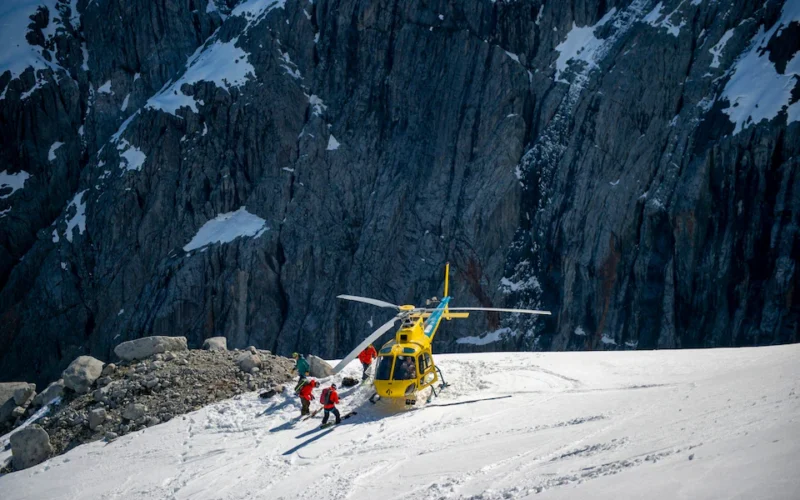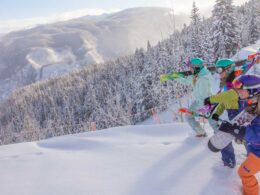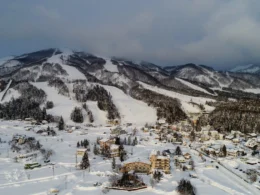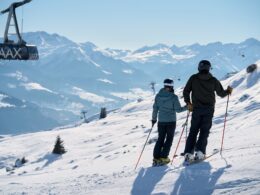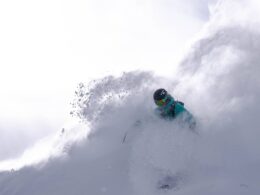When Europe’s mountains close for summer, the Patagonian Andes beckon skiers in search of first descents and top-tier exploration.
There’s a rare game that only a few skiers ever get to play in their lifetime: “ski a run, name a run.” And on my first roll of the dice, I hit the jackpot.
Standing before the track I had etched into untouched white canvas, surrounded by jagged peaks of the Andes, I pondered my achievement. How had an average skier like myself ended up conquering the giants of one of the world’s most cherished wildernesses, now with a first descent to my name?
Skiing in the remote reaches of Patagonia might seem reserved for ski movie stars – and to a large extent, it is. Spanning over 400,000 square miles across Chile and Argentina, this region is among the most inaccessible on Earth. Stretching from the southern tip of the Andes, flanked by lakes, fjords, rainforests, and glaciers, it demands both an adventurous spirit and a healthy budget to explore its untamed corners.
The name “Patagonia” is thought to originate from the Spanish explorers who first described the native tribes as giants (patagón). While commercial ski resorts like Portillo near Santiago and Cerro Catedral near Bariloche have long been accessible, the farthest reaches of this vast playground – home to some of the last untouched mountains on the planet – are now open to skiers eager to venture further, regardless of their expertise.
Operating from the off-grid Eleven Rio Palena Lodge, Eleven Experience is pioneering unforgettable heli-skiing adventures. Founded by Chad and Blake Pike, an American couple, Eleven Experience boasts 13 properties worldwide, embodying the concept of “taking it to 11.” In less than 48 hours with them, I had already pushed my limits beyond what I thought possible.
As my flight descended toward Santiago, the Andes loomed like waves on the horizon. Continuing from the Chilean capital to Puerto Montt and then by an eight-seater prop plane to Palena airstrip, I glimpsed the adventure awaiting. Flying over snow-capped volcanoes and rugged peaks that dissolved into dense forests, the journey unveiled the epic scale of what lay ahead.
Nestled on the Palena River’s bank, Eleven Rio Palena Lodge spans three floors with seven bedrooms. Arriving in spring in the Southern Hemisphere – heli-skiing season from September to October – I found the surrounding 35 acres of private land lush and teeming with wildlife.
Inside, the lodge blended sleek modern amenities with cozy aesthetics: polished wood floors, native stone fireplaces, and shelves stocked with National Geographic, ski literature, and bird-spotting guides. As a five-star adventure lodge, it boasted an equipment room outfitted for a week of exploration, a wood-fired hot tub, an outdoor Asado area for traditional barbecues, and a spacious terrace perfect for stargazing. Outside, two helicopters gleamed on the lawn.
At the evening safety briefing, lead guide Mike Barney’s advice was simple yet crucial: “Don’t let the helicopter overwhelm you. Relax and focus on what you can control.” Demonstrations covered approaching the helicopter, huddling during descent, and boarding calmly when signaled. Anxiety about my technical skills dissolved with Barney’s assurance that heli-skiing here isn’t just for extreme athletes – the pace is intentionally slowed to accommodate all levels.
The next morning, I rose early to watch pilots prepare their machines. After breakfast, we donned harnesses and avalanche gear from the equipment room. Following a review of helicopter protocols, nerves settled as we boarded for takeoff.
Lifting from the lodge’s lawn, the valley’s serenity unfolded beneath us. Ahead lay a landscape more breathtaking than any I had seen: vast and rugged, more akin to the Himalayas than the Alps. Our pilots navigated daringly through the rock towers of Las Tres Monjas, revealing slopes ranging from steep couloirs to gentle glaciers. Eleven’s terrain spans 2.3 million acres, offering slopes tailored to every skill level.
“We’re explorers here,” Barney emphasized. “Discovering new ridges and ski terrain – that’s what inspires us.”
For someone accustomed to groomed Alpine pistes, skiing on virgin snow amid uncharted mountains was surreal. Barney led, and I followed eagerly, carving effortlessly through soft spring powder. Confidence grew with each turn, laughter echoing off the mountains around me. Heli-skiing wasn’t daunting; it was pure euphoria.
As I skied to a graceful stop next to Barney and the waiting helicopter after a 600-meter descent, he declared, “That run is yours – you’re the first.” Endorphins surged through me.
True to Eleven’s ethos, each day delivered more sensory thrills. Over our stay, we conquered numerous drops, exploring runs with names like Schnitzel, Hung Jury, and Excalibur – new descents charted and rated by our guides. Only in the remote Himalayas or Georgia’s wilderness could comparable exploration be found at such fingertips.
Days weren’t confined to the slopes. Weather permitting, helicopters whisked us to Eleven’s river camp for rafting on the Futaleufú River, known as “big water” for its origin in Argentina’s Los Alerces National Park. Additional excursions included après-ski in natural hot springs, paddleboarding on the Palena River, and trailblazing through dense forests to thundering El Tronador waterfall.
